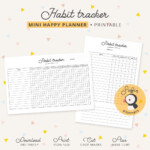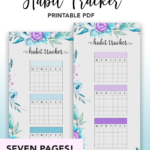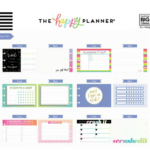The Happy Planner Habit Tracking Happy Journal Accessories Pack – Have you wondered why certain people seem to achieve their goals in a manner other people can’t? The secret could be the power of a simple and effective tool called a Habit tracker printable. What is a habit tracker printable, and how will it improve your daily routine? Find out more.
Understanding the importance of Habit Tracking
The process of tracking your habits goes far more than just a simple process of completing boxes on paper. It’s a deliberate and conscious method of building and maintaining healthy habits.
The Role of Printables for Habit Tracker
Habit tracker templates act as visual reminders as well as accountability partners, urging you to stay committed to your goal.
Printable Habit Tracker
It’s simple to use however, you have to be honest with yourself before you make a commitment.
Choosing Habits to Keep
The choice of habits that will help you reach your goals is the very first step. It could be doing 20 minutes of reading each day, practicing yoga, or drinking eight glasses of water every day.
Logging Your Progress
Record your daily progress in the habit tracker printable. This takes just a few minutes but can provide valuable insight into your journey to build habits.
Analyzing Performance
In time, you’ll be able identify patterns, identify obstacles and assess which modifications can help you improve your process of habit formation.
Habit Tracker printables: Advantages and Benefits
Downloadable habit tracker printables offer many additional benefits besides aiding you in developing new behaviors.
Improved Self-Awareness
By tracking habits, you gain self-awareness and find out what works for you.
How to Boost Productivity
If you can see your daily routines clearly, you will be able to get rid of the ineffective ones and pay attention to the habits that will help you in your personal and professional development.
Inspire Consistency
Habit tracker printables promote consistency, which is key to turning sporadic activities into habits that are ingrained.
Tips for Effectively Tracking Habits
Utilize these suggestions to increase the effectiveness of the use of your habit-tracking device.
Start Small
Focus on just one to two habits. This will help you to not feel overwhelmed, and be more likely to stick to the new routines.
Be Consistent
Consistency plays a key role in the formation of habits. Make it a point to update your habit tracker’s template daily.
Celebrate Your Successes
Recognize your wins regardless of how small. This boosts your confidence and encourages you to keep going.
Conclusion
The habit tracker printable is an excellent device to establish and sustain good routines. By offering visual reminders, encouraging the habit of consistency, and boosting productivity and self-awareness they can change your approach to personal growth. Start small, remain constant, and be proud of your successes as you go.
Frequently Asked Questions
- Where do I find the habit tracker printables?
- On many websites, you can print habit trackers on a variety of websites. Some provide them for no cost, while others charge a small cost for more advanced versions.
- Can I use a digital tracker for my habits instead of printing a paper copy?
- Absolutely! Numerous apps to track your habits are available. However, some individuals find the act of physically recording a complete habit more enjoyable and tangible.
- How many of my habits should I track at once?
- Start small. It’s advisable to focus on a couple of routines at first. Once you’ve successfully incorporated these into your routine, you can start adding more.
- What’s the average time it takes to create the habit
- It is believed that it can take between 21 and 65 days to develop a new habit. The amount of time required to form a habit can vary depending on an individual’s complexity and the character of their.
- Should I worry about missing one day on my daily recorder?
- It’s not uncommon to have a few days off. It’s not essential to do anything to discourage. It is better to use the experience to learn and understand the reasons for what was wrong.


